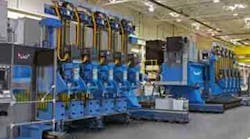A new machining concept will have a big, bold debut thanks to a California manufacturer —and the impending rise in demand for large-dimension titanium components. Aerospace Dynamics International will install eight MAG XTi profiler machines with five spindles each, arranged as four profilers that each will have two pairs of 300-foot X-axis rails. The addition is seen increasing ADI’s titanium machining capacity by 40%.
Airbus SAS and Boeing Commercial Airplanes plan to produce nearly 15,000 new jets in the coming decade, driving concerns that there is not enough capacity available to machine the titanium parts that are such an important part of the OEMs' new fuel-efficient plane designs.
ADI’s expansion project is part of a reported $90-million capital program that already has included two MAG profilers from the same XTi series. Those two five-spindle machines will start production this quarter, according to ADI president and CEO John Cave, speaking at the announcement of the new order.
ADI is a Tier One aerospace supplier in Valencia, Calif. that specializes at machining large, complex structures. Cave asserted that his company will solidify its position in the global supply chain for commercial jet production, but noted that it needs “more spindles” to process titanium. He said the 40% increase in titanium machining capacity available from the new MAG units would help ADI “to maintain (its) global competitiveness.”
“We are producing some significant titanium assemblies and sideframe components for the Airbus A350 that require lots of heavy machining, and we expect these machines to fill a big role in reaching our contracted ramp-up rates,” Cave detailed. ADI also has contracts for the Boeing 737, 777 and 787; the Airbus A330, A350 and A380; and the Lockheed Martin F-35 programs.
MAG indicated ADI’s latest, $36-million machinery purchase is one of the largest single aerospace orders in its history, in terms of total value and number of spindles.
The original Ti profiler model was introduced in 2007, as MAG recognized the risingdemand for aerospace titanium parts. The three-axis XTi profilers installed at ADI this year set a record for titanium removal rates at 90+ cu.in./min., and the new 5-axis gantry versions will have the same high-stiffness frame construction.
“The three-axis version of this machine really proved itself, and the new five-axis version builds on this platform,” Cave said. “We set demanding requirements for the five-axis machines, and MAG stepped up with a complete new approach that is superior to anything else on the market.
"Capabilities we never had before"
“This is a major breakthrough in gantry design that gives us capabilities we never had before,” he continued. “Set-up will be easier and accuracy will be on par with the three-axis design. The rotary axes on each spindle can be independently calibrated and controlled to enhance accuracy and simplify setup. And, for three-axis roughing operations, the rotary axes can be automatically locked for additional control over the final machining setup.“
The 40 spindles will be carried on eight individually controlled gantries, with four gantries each mounted on two pairs of 91.4 m (300 ft) X-axis rails. The gantries span a 6 m (20 ft) Y-axis, with a Z-axis depth of 711 mm (28 in). Between each pair of rails, the work envelope will cover 1,300 sq.m (14,000 sq ft). Each spindle’s angular A and B axes can travel ±30 degrees, with accuracy ensured by digital scale feedback.
At ADI, the machines will be equipped with 52-kW (70 hp), 7,000-rpm spindles, and each spindle will deliver up to 1,345 Nm (986 ft lb) of torque into the cut at 40-7,000 rpm. The standard XTi spindle is normally rated 51 kW (68 hp), 3,500-rpm, and produces 2,523 Nm (1860 ft lb) torque.
“A multi-spindle machine that can rough and finish titanium at this rate gives us a real competitive edge,” Cave explained. “A single-spindle machine runs at roughly the same speeds and feeds, yet our machines complete five parts in the same cycle time, so we are much more efficient than we could be with individual machines. In addition, our infrastructure overhead is reduced, compared to what we would need for 40 discrete machines on the floor.”
The two MAG five-spindle three-axis XTi profilers were part of an expansion that included two MAG U5 portal mills and two MC 1600 boring mills. It also ordered tooling and applications support from MAG's Productivity Solutions business, and Freedom eLOG® factory monitoring software from MAG Delta 4.
ADI’s coming expansion will cover 120,000 square feet, and it will mean it has 600,000 square feet under roof.
“When the OEMs decided to use composite fuselages, we knew the substructures would have to be exceptionally strong and rigid, probably requiring titanium, so we switched our emphasis from aluminum machining to Ti,” Cave said of his company’s strategy. “This really paid off for us as the percent of Ti in aircraft skyrocketed. Looking at our backlog, we are already considering whether to add another pair of X-axis rails for some additional three-axis machining capacity in our new Building Seven.”







